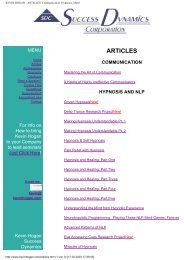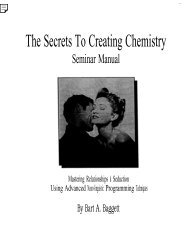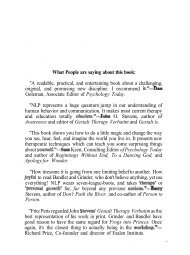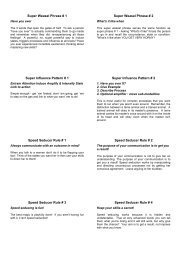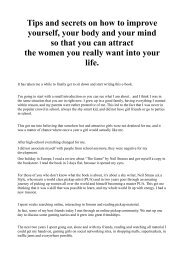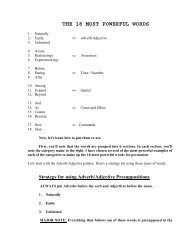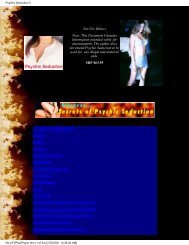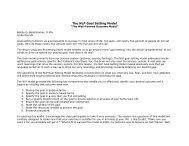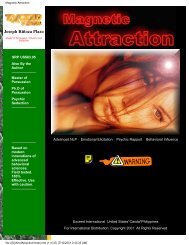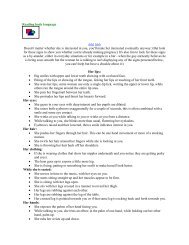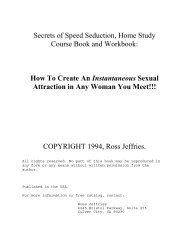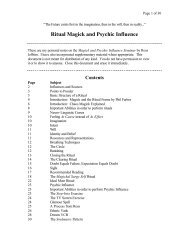A Pragmatic Guide To Communication & Change.pdf - NLP Info Centre
A Pragmatic Guide To Communication & Change.pdf - NLP Info Centre
A Pragmatic Guide To Communication & Change.pdf - NLP Info Centre
- No tags were found...
You also want an ePaper? Increase the reach of your titles
YUMPU automatically turns print PDFs into web optimized ePapers that Google loves.
ith<br />
stand side-y-erde w an Eskimo and look at the snow, we would not "see" the same<br />
thing because our models of the world are different. The same is true of individuals who<br />
come into therapy. As we shall see, it is often through their<br />
language that their limited or distorted perception of the world can be known. With this<br />
knowledge we can assist them in learning new ways to talk about their experiences, ways<br />
that will ultimately change their models of the world.<br />
Social Constraints<br />
Another way we create differences in our models is through social constraints. This<br />
filter might be thought. ofas the second level in the model-building process, coming just<br />
after neurological constraints. The primary exazople of social constraints is language,<br />
which operates on our models of the world in two primary and apparently opposite ways.<br />
One way is to enhance and the other is to limit our per, ifAlor of the world around us. It<br />
does this by encoding perceptuel phenomena into labels (words) which are manipulated<br />
by the mind in its efforts to make sense out of experieo-., For example, eskimos have<br />
some seventy different words for snow."' They are able to make distinctions about the<br />
quali0 and structure of snow that are beyond the abilities (d most individuals in the rest of<br />
the world. Obviously this 1, 1<br />
, great survival value to the Eskimo culture. This<br />
deeply'oot od social constraint, exhibited in the Eskimo language, onp+us d, their models of<br />
the world to include perceptions that people from other linguistic backgrounds are unable<br />
to ohserve . An interesting phenomenon occurs when soma"""' 1'u comes fluent in a<br />
language different from his native ton4ue<br />
'there are other forms of social constraints that affect a person's modeling process. As<br />
Coleman' put it, " . his Personality<br />
w development reflects both the larger society in<br />
w<br />
hich he lives .<br />
y<br />
and tech<br />
its institutions, traditions, values, ideas,<br />
intc.nologies - and the immediate family end other rPersonal relationships. ... " (p. 78)<br />
Social customs and<br />
filter it as it comes in. For example, we know that there are sounds both above and la-l- ti,<br />
ability of the human ear to hear, and we know that there are non-visible areas of the<br />
electromagnetic spectrum. This knowledge has been gained through the use of artificial<br />
Mechanisms which translate or re-present these areas into perceivable stimuli. A good<br />
portion of my work as a teacher and counselor is to operate much like those machines.<br />
That is, I work to represent aspects of the environment that they are filtering out or<br />
deleting from their experience. There will be more on that in upcoming sections.<br />
Difference threshold is another term used in the study of perception. This is the minimum<br />
amount of stimulation necessary to be able to detect a difference between two similar<br />
stimuli. This just noticeable difference (j.n.d.) supports the notion that our receptor<br />
organs act as filters to our perception of the world.<br />
Another important concept in the study of perception is the fact that our sensory mechanisms<br />
operate on a process called recurrent inhibition. Because of this neural mechanism,<br />
we tend to receive information from our sense, primarily about changes in our<br />
environment rather than about constant or unchanging aspects of experience. One of the<br />
reasons for including a good bottle of wine with a meal is to stimulate our gustatory-



